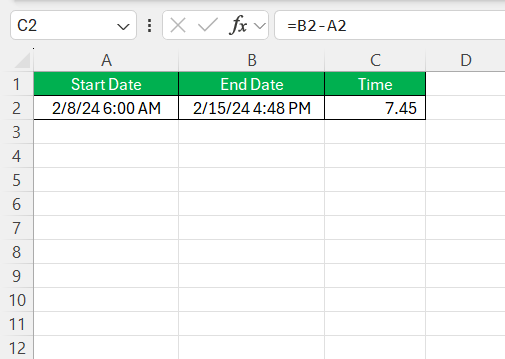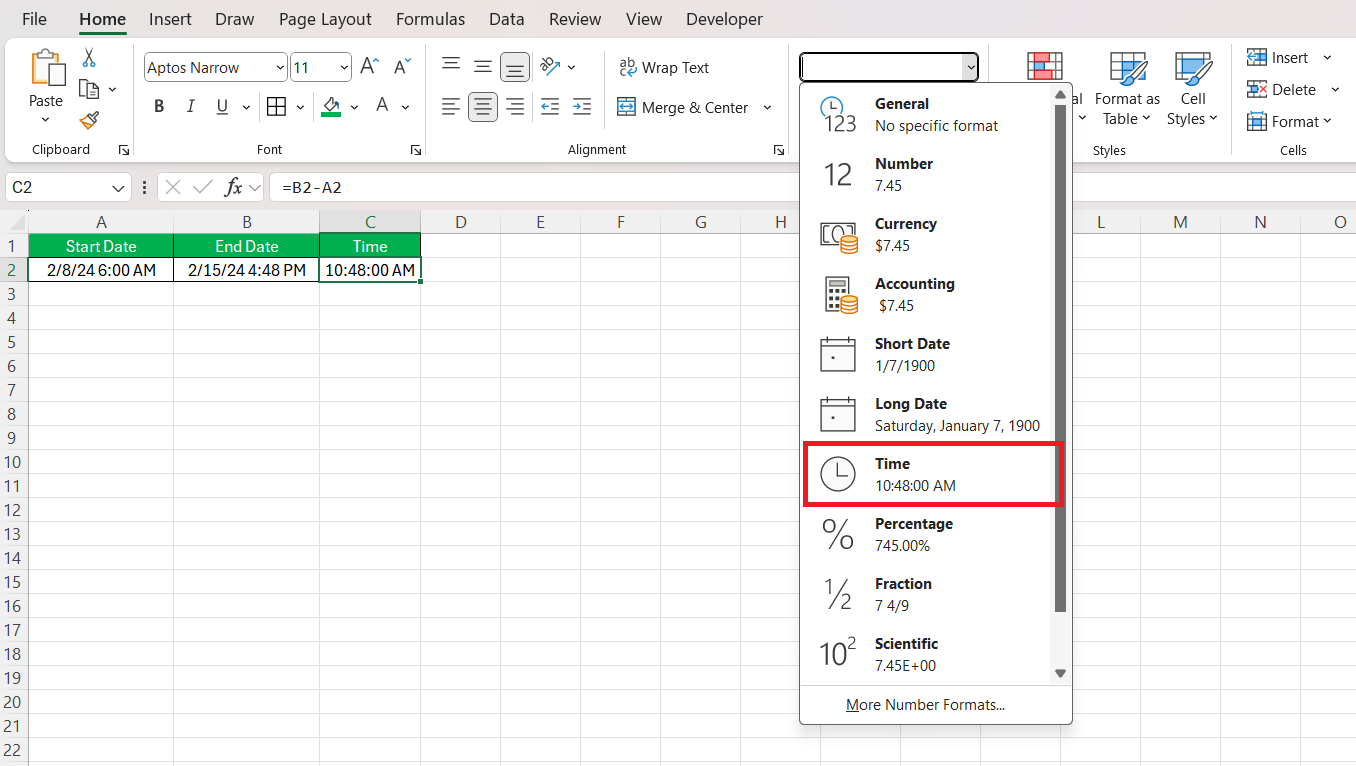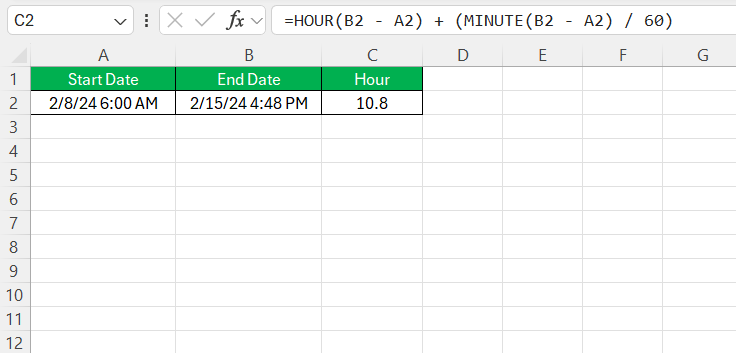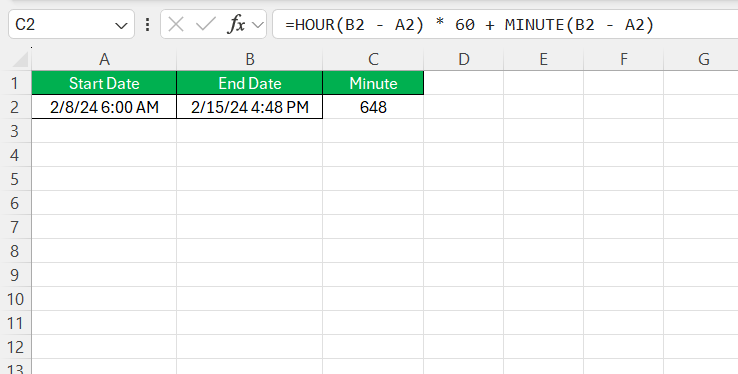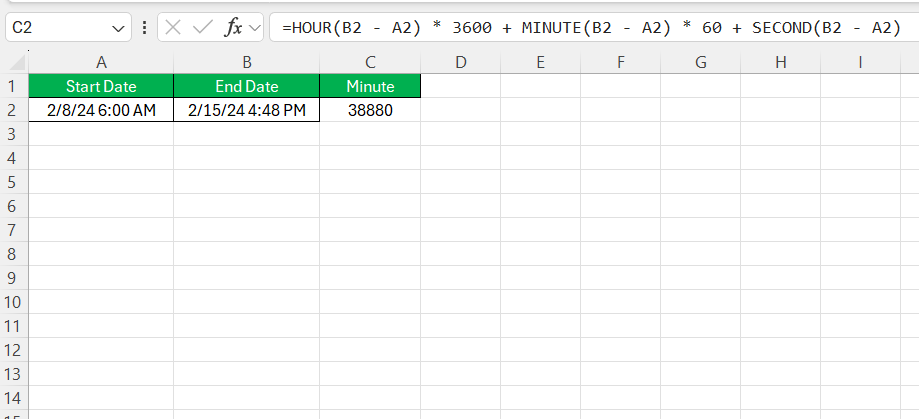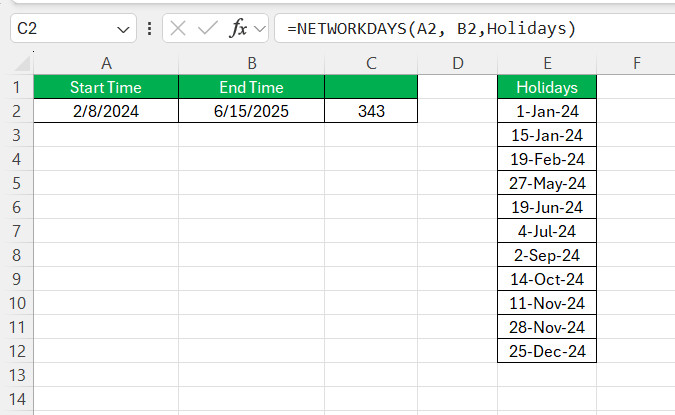When I need to calculate the time elapsed in Excel, I use a few different methods depending on the task at hand. Whether I’m tracking work hours, figuring out time differences, or measuring how long a project takes, Excel has a lot of tools that make the process straightforward. In this article, we will cover different methods of calculating time elapsed in Excel.
Key Takeaways:
- Subtracting start and end times in Excel is the simplest way to calculate time elapsed.
- Use Excel functions like
HOUR,MINUTE, andSECONDto break down elapsed time into hours, minutes, or seconds. - The
DATEDIFfunction provides a detailed breakdown of elapsed time between two dates. - The
NETWORKDAYSfunction is useful for calculating elapsed workdays, excluding weekends and holidays.
Methods on Calculating Time Elapsed
Basic Time Subtraction
The easiest way I calculate the time elapsed between two times or dates is by subtracting one from the other. Excel treats dates and times as numbers, where dates are whole numbers and times are fractional values of a day.
Example: If I have a start time in cell A2 and an end time in cell B2, I use this formula:
=B2 – A2
To make sure the result looks right, I format the cell as a time value (hh:mm:ss or h:mm AM/PM).
Calculating Elapsed Time in Hours, Minutes, or Seconds
Sometimes I need to know the exact number of hours, minutes, or seconds that have passed. Excel has functions that help me break it down:
Elapsed Time in Hours:
=HOUR(B2 – A2) + (MINUTE(B2 – A2) / 60)
This formula gives me the hours, and I add any minutes as a fraction of an hour.
Elapsed Time in Minutes:
=HOUR(B2 – A2) * 60 + MINUTE(B2 – A2)
This converts the hours to minutes and then adds the remaining minutes.
Elapsed Time in Seconds:
=HOUR(B2 – A2) * 3600 + MINUTE(B2 – A2) * 60 + SECOND(B2 – A2)
Here, I convert both hours and minutes to seconds and then add the seconds.
Calculating Elapsed Time Between Dates
When I want to find out how much time has passed between two dates, I can just use the DATEDIF function:
=DATEDIF(A2, B2, “Y”) & ” years, ” & DATEDIF(A2, B2, “YM”) & ” months, ” & DATEDIF(A2, B2, “MD”) & ” days”
This formula gives me a detailed breakdown of the elapsed time.
Using the NETWORKDAYS Function for Elapsed Workdays
If I’m working with business days, the NETWORKDAYS function comes in handy. It calculates the number of workdays between two dates, excluding weekends and holidays.
Example:
=NETWORKDAYS(A2, B2, holidays)
I include a list of holidays to exclude them from the count, which is really useful for project timelines or payroll.
Table of Contents
Conclusion
Calculating time elapsed in Excel is something I do often, and it’s a skill that comes in handy for various tasks. Whether I’m using simple subtraction or the DATEDIF function Excel gives me all the tools I need to get accurate time calculations. By mastering these techniques, I can manage my time and projects more effectively.
FAQ: Expert Answers to your Time Calculation Questions
How do I calculate time difference over 24 hours without errors?
To calculate the time difference over 24 hours without encountering errors in Excel, you can use the formula `=(B2-A2)*24`, ensuring that your start time and end time are correctly formatted. If the result appears negative because the period crosses midnight, you may need to adjust the formula to `=((B2+(A2>B2))-A2)*24`. This modified formula accounts for the crossover past midnight, preventing negative time differences. Always set the cell format to General to display the result as a decimal value.
Can Excel handle time calculations across different time zones accurately?
Yes, Excel can handle time calculations across different time zones accurately by using appropriate functions and formulas to convert times from one time zone to another before performing calculations. Users must manually account for time zone differences when setting up their formulas, but once set up correctly, Excel can efficiently manage time calculations, including those that cross time zones.
What are some quick methods to sum or subtract time in Excel?
- To quickly sum time in Excel, you can utilize simple addition with cell references (e.g., `=A1+B1` if both A1 and B1 contain time values).
- For subtracting time, use a similar subtraction formula (e.g., `=A2-B2`), or employ the TIME function for adding or subtracting under 60 minutes by specifying the minutes in the formula (e.g., `=A2 + TIME(0, 20, 0)` to add or `=A2 – TIME(0, 30, 0)` to subtract).
- When dealing with more than 60 minutes, divide the number of minutes by 1440 (minutes in a day) and add or subtract that fractional value from your base time cell.
What is the formula for calculating time elapsed in Excel?
The formula for calculating time elapsed in Excel is to subtract the start time from the end time using a simple subtraction formula, which in a cell would look like `=EndTime – StartTime`. To properly display the result, you should apply a time format to the cell where the formula is entered. For instance, if your start time is in cell B4 and your end time is in cell C4, the formula would be `=C4-B4`.
How do I calculate the difference between two times in excel?
To calculate the difference between two times in Excel, you can simply subtract the start time from the end time using a formula like =End time – Start time. If the cells contain the actual times (formatted as such), the result will be a decimal number representing the time difference. To display this result more meaningfully, you can then apply custom time formatting using codes like ‘h’ for hours, ‘h:mm’ for hours and minutes, or ‘h:mm:ss’ for hours, minutes, and seconds, ensuring the result is in a readable time format.
John Michaloudis is a former accountant and finance analyst at General Electric, a Microsoft MVP since 2020, an Amazon #1 bestselling author of 4 Microsoft Excel books and teacher of Microsoft Excel & Office over at his flagship MyExcelOnline Academy Online Course.

